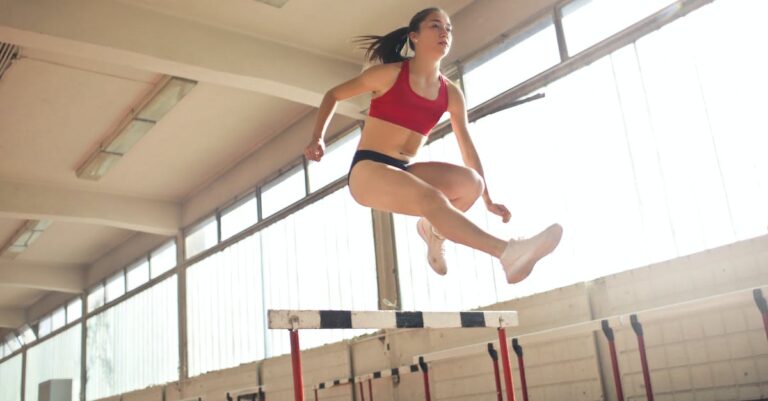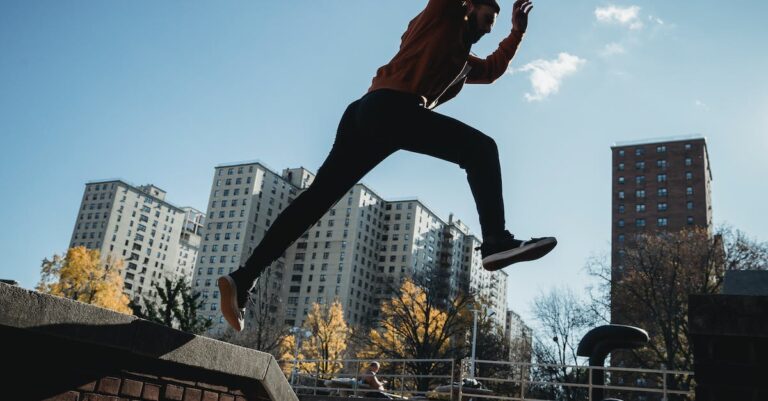Soaring to New Heights: Training and Techniques for Advanced Trampoline Skills
Introduction
Overview of advanced trampoline skills
In the world of trampoline sports, advanced skills take athletes to new heights, both literally and figuratively. These skills go beyond the basic jumps and flips, pushing the boundaries of what is possible on a trampoline. The overview of advanced trampoline skills provides a glimpse into the thrilling and challenging techniques that trampolinists can master. From intricate aerial maneuvers to complex combinations, advanced trampoline skills require a combination of strength, agility, and precision. This paragraph sets the stage for the exciting journey ahead, where athletes will soar to new heights through dedicated training and perseverance.
Benefits of mastering advanced trampoline skills
Mastering advanced trampoline skills offers a wide range of benefits. Not only does it provide an exhilarating and thrilling experience, but it also improves physical fitness and coordination. By pushing the boundaries of what is possible on a trampoline, individuals can enhance their strength, agility, and balance. Additionally, mastering advanced trampoline skills can boost self-confidence and self-esteem as individuals overcome challenges and achieve new heights. Whether it’s performing complex flips, twists, or somersaults, the mastery of advanced trampoline skills is a testament to dedication, perseverance, and skill.
Importance of proper training and techniques
The importance of proper training and techniques cannot be overstated when it comes to advanced trampoline skills. Without the right training, individuals may be at a higher risk of injury and may not be able to reach their full potential. Proper techniques, such as body positioning, timing, and control, are essential for executing complex maneuvers and achieving impressive heights on the trampoline. Additionally, training under the guidance of experienced coaches can help athletes develop the necessary strength, flexibility, and coordination required for advanced trampoline skills. By prioritizing proper training and techniques, trampolinists can enhance their performance, minimize the risk of accidents, and enjoy the exhilarating experience of soaring to new heights on the trampoline.
Safety Precautions

Importance of warm-up and stretching
The importance of warm-up and stretching cannot be overstated when it comes to advanced trampoline skills. Before attempting any high-intensity or complex maneuvers, it is crucial to prepare the body for the physical demands ahead. A proper warm-up increases blood flow to the muscles, improves flexibility, and reduces the risk of injury. Stretching helps to lengthen and loosen the muscles, allowing for greater range of motion and improved performance. By incorporating a thorough warm-up and stretching routine into your trampoline training, you can enhance your overall performance and minimize the chances of accidents or muscle strains.
Wearing appropriate safety gear
Wearing appropriate safety gear is of utmost importance when engaging in advanced trampoline skills. The high-flying nature of these maneuvers puts the body at risk of serious injury if proper precautions are not taken. To minimize the chances of accidents, it is crucial to wear a well-fitted helmet, knee pads, elbow pads, and wrist guards. These protective gears provide cushioning and support to vulnerable areas, reducing the impact of falls and collisions. Additionally, it is essential to wear non-slip footwear to maintain grip and stability on the trampoline surface. By prioritizing safety and wearing the right gear, trampolinists can enjoy pushing their limits while minimizing the risk of harm.
Supervision and spotting techniques
Supervision and spotting techniques are crucial when it comes to advanced trampoline skills. Trampoline activities can be risky, especially when attempting complex maneuvers and tricks. Proper supervision ensures the safety of the trampolinist and helps prevent accidents or injuries. Trained spotters play a vital role in providing guidance and support during high-risk moves, offering assistance and ensuring a controlled landing. By implementing effective supervision and spotting techniques, trampolinists can push their limits while minimizing the risk of accidents and maximizing their performance.
Building Strength and Flexibility

Exercises for strengthening core muscles
Exercises for strengthening core muscles are essential for advanced trampoline skills. A strong core provides stability and control, allowing athletes to execute complex and dynamic movements with precision and power. Some effective exercises for strengthening the core include planks, Russian twists, and bicycle crunches. These exercises target the abdominal muscles, obliques, and lower back, which are all crucial for maintaining balance and generating explosive force on the trampoline. Incorporating these exercises into a regular training routine can greatly enhance an athlete’s performance and reduce the risk of injuries.
Stretching routines for improved flexibility
Stretching routines are essential for improving flexibility and maximizing performance in advanced trampoline skills. By incorporating a variety of stretching exercises into your training regimen, you can increase your range of motion, prevent injuries, and achieve greater control and precision in your movements. Some effective stretching techniques for trampoline athletes include dynamic stretching, static stretching, and proprioceptive neuromuscular facilitation (PNF) stretching. Dynamic stretching involves actively moving your muscles and joints through a full range of motion, while static stretching involves holding a stretch for a prolonged period of time. PNF stretching combines static stretching with muscle contraction and relaxation to further enhance flexibility. It is important to perform these stretching routines both before and after trampoline sessions to warm up the muscles and prevent muscle tightness. By dedicating time to stretching, trampoline athletes can optimize their performance and reach new heights in their skills.
Incorporating cross-training exercises
Incorporating cross-training exercises is essential for those looking to take their trampoline skills to new heights. By engaging in a variety of exercises that target different muscle groups and enhance overall fitness, trampoline enthusiasts can improve their strength, flexibility, and coordination. Cross-training exercises such as weightlifting, yoga, and plyometrics can help build the necessary power and stability required for advanced trampoline tricks. Additionally, incorporating cardio exercises like running or cycling can improve endurance, allowing individuals to perform longer and more challenging routines. By diversifying their training regimen, trampoline athletes can enhance their performance and reduce the risk of injury, ultimately reaching new heights in their skills and abilities.
Mastering Basic Skills

Perfecting basic trampoline jumps
Perfecting basic trampoline jumps is essential for anyone looking to advance their trampoline skills. These jumps serve as the foundation for more complex moves and tricks, providing a solid base of technique and control. By focusing on mastering the basics, trampolinists can develop the necessary strength, balance, and coordination needed to execute advanced maneuvers with precision and grace. Whether it’s perfecting a simple tuck jump or honing the technique for a straight jump, dedicating time to perfecting these fundamental skills is key to reaching new heights on the trampoline.
Learning proper body positioning
In order to master advanced trampoline skills, learning proper body positioning is crucial. This involves understanding how to maintain balance and control while executing various flips, twists, and rotations in the air. By practicing correct body alignment and posture, athletes can maximize their potential for achieving higher jumps and executing more complex maneuvers. It is important to focus on core strength and flexibility, as well as body awareness, to ensure safe and efficient movements on the trampoline. Additionally, receiving guidance from experienced coaches or trainers can greatly enhance the learning process and help athletes develop the necessary skills to soar to new heights.
Developing coordination and balance
Developing coordination and balance is essential when it comes to mastering advanced trampoline skills. Trampoline enthusiasts who aim to soar to new heights must focus on honing their coordination and balance abilities. This involves practicing various exercises and drills that challenge their body’s stability and control. By improving coordination, individuals can synchronize their movements and execute complex tricks with precision. Additionally, developing balance allows trampolinists to maintain stability while performing intricate maneuvers in mid-air. Whether it’s through balance exercises or coordination drills, dedicated training in these areas is crucial for those seeking to push the boundaries of their trampoline skills.
Progressing to Advanced Tricks

Understanding the physics of trampoline jumps
Understanding the physics of trampoline jumps is crucial for mastering advanced trampoline skills. Trampolines operate based on the principles of elasticity and momentum, which play a significant role in the height and power of each jump. When a person jumps on a trampoline, the springs or bungee cords underneath compress and store potential energy. As the jumper pushes off the trampoline bed, this potential energy is converted into kinetic energy, propelling them into the air. Understanding how to manipulate these forces allows trampolinists to perform impressive flips, twists, and combinations with precision and control. By comprehending the physics behind trampoline jumps, athletes can optimize their technique and maximize their performance, ultimately reaching new heights in their trampoline skills.
Learning flips, twists, and somersaults
Learning flips, twists, and somersaults is an exciting and challenging aspect of advanced trampoline skills. Mastering these aerial maneuvers requires a combination of strength, coordination, and precise technique. Flips involve rotating the body in mid-air, while twists add an extra level of difficulty by incorporating a twisting motion. Somersaults, on the other hand, involve a complete rotation of the body from start to finish. To learn these skills, trampoline enthusiasts can benefit from professional training and guidance, as well as a progressive approach that allows for gradual skill development. With practice and determination, individuals can elevate their trampoline abilities and experience the thrill of performing impressive flips, twists, and somersaults in the air.
Practicing advanced combinations and sequences
Practicing advanced combinations and sequences is essential for trampoline enthusiasts looking to take their skills to new heights. By combining various flips, twists, and rotations, athletes can create impressive and visually stunning routines that showcase their mastery of the trampoline. However, mastering these complex combinations requires dedication, patience, and a solid foundation in basic trampoline skills. It is important to start with simple combinations and gradually progress to more challenging ones, ensuring proper technique and safety at all times. Regular practice, under the guidance of a trained coach, can help trampoline enthusiasts improve their coordination, timing, and body control, enabling them to execute intricate sequences with precision and confidence. With consistent practice and a focus on technique, trampoline athletes can push their boundaries and unlock a whole new level of skill and artistry.
Training Tips and Techniques

Setting goals and tracking progress
Setting goals and tracking progress are essential components of any training program, and trampoline skills are no exception. Whether you’re a beginner or an advanced trampolinist, having clear goals can help motivate you and provide a sense of purpose in your training. By setting specific, measurable, achievable, relevant, and time-bound (SMART) goals, you can effectively track your progress and ensure that you’re constantly pushing yourself to new heights. Additionally, tracking your progress allows you to identify areas for improvement and make necessary adjustments to your training regimen. Whether it’s increasing the difficulty of a specific skill or mastering a new technique, setting goals and tracking your progress will undoubtedly lead to greater success in your trampoline journey.
Utilizing training aids and equipment
Utilizing training aids and equipment is crucial for athletes looking to master advanced trampoline skills. These tools not only enhance the training experience but also provide the necessary support and safety measures. One popular training aid is the trampoline harness, which allows athletes to practice complex flips and twists without the fear of injury. Additionally, the use of foam pits and spotting belts can help athletes perfect their landings and improve their overall technique. By incorporating these training aids and equipment into their practice routines, athletes can push their boundaries and reach new heights in their trampoline skills.
Working with a trampoline coach or instructor
Working with a trampoline coach or instructor is essential for anyone looking to take their trampoline skills to the next level. These professionals have the knowledge and experience to guide athletes through proper techniques, provide personalized training plans, and offer valuable feedback and corrections. Whether you are a beginner or an advanced trampolinist, working with a coach can help you refine your skills, improve your form, and prevent injuries. They can also introduce you to new and challenging maneuvers, pushing you to reach new heights in your trampoline journey. With their expertise and guidance, you can confidently tackle advanced trampoline skills and achieve your goals.







